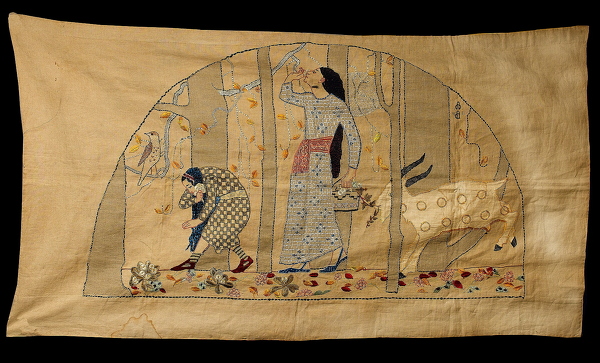
 SOLD
SOLD
Maxwell Armfield:
Damsels in a Wood, 1916
Unframed (ref: 4431)
Signed with each
artist’s monogram between the date
‘1916'
Embroidered lunette, silk and woollen threads
on rectangular unbleached linen ground, 37 x 76 in. (94 x 193 cm.)
Tags: Maxwell Armfield embroidery/needlework design farms/domestic animals
Provenance: The Artist's Studio
Prov: coll. the
late Dr. Paul van Saanen
Lit:
Maxwell Armfield 1881-1972, Southampton Art Gallery 1978; Nicola Gordon
Bowe, ‘Maxwell Armfield 1881-1972: an
account of his decorative art’ in Aspects of British Interior Design
(The Journal of the Decorative Arts Society 1850 to the present, no. 12), ed.
Barbara Morris, Brighton 1986, pp.
26-37; Nicola Gordon Bowe, ‘Constance
and Maxwell Armfield: An American Interlude 1915-1922, The Journal of Decorative
and Propaganda Arts, no. 14, Fall 1989,
pp. 8-27.
This striking composition, epitomizing the
Armfields’ Arts and Crafts background and their current work with avant-garde theatre design, depicts
two damsels frozen in mid-action as they proceed through a wood.
One bends to pick the lustrous flowers that carpet their path; the other
savours the scent of a flower
before adding it to her basket, while a capricious goat, in mid-bound, munches an ivy leaf trailing from it. A mistle thrush is the only other
protagonist, perched on the branch of one of
the grey tree trunks that provide a strong, neutral vertical rhythm to
the girls’ frieze-like progression. A
thin line of black running stitch delineates their forms, while the
profiled girls and goat are outlined in the colours used for the
decorative patterns which describe their forms.
The girls’gestures, their long
dark hair, one girl’s stripey stockings, and the goat’s black horns and hooves
emphasize these. Warm reds are used for
shoes, a geometrical sash, a hair band and fallen leaves, while
the silk of golden leaves on hanging
fronds catches the light.
The Armfields had worked in close collaboration
since their marriage in January 1909, whether in the experimental community theatre
that was central to their lives in Gloucestershire, in London and, between 1915 and 1922, in California and New York, or on the various
books, poems and articles that they wrote and
illustrated. In the autumn of
1916, the year of this panel, the International
Studio magazine featured a three page
article on the embroidered work they had exhibited with the National
Society of Craftsmen; this was held at the
New York Arts Club on Gramercy Park,
where they had a studio apartment
and re-established their Greenleaf Theatre during much of the First World War. It is
likely that this panel featured
in this 1916 exhibition, which was
rapturously reviewed in the press.
That December, Armfield was recorded by his wife as covering the bare rooms of
their apartment with flowers, while she made samplers and cushions and gave a
course of eight lectures on English
embroidery, and he painted murals,
canvases, tempera panels and made wall-hangings and embroideries. She particularly noted some “wonderful
embroidered flowers on black silk - a jewelled blaze of colour”, which appeared
on the cover of the December 1916 issue of
the fashionably progressive American Ladies Home Journal. The following year, they began making
embroidered hangings on a larger scale, as screens and wall and table covers,
perhaps prompted by the scale of this piece.
Their friends, the McKnight Kauffers, were instrumental in suggesting
exhibition venues on both coasts of America.
It was not long before both Armfields were in demand, one critic noting
how “intensely modern, both in his mentality and in his technical
accomplishments” the versatile young Mr. Armfield was.
For several
years, Maxwell Armfield’s designs, whether stencilled, embroidered or
painted on fabric, drawn or painted on paper, panel or canvas, had favoured outlines rather than
tones or any suggestion of voluminous forms, the frozen
frieze-like action of his figures
emulating eurhythmic poses. His
tempera illustrations and costume and set
designs for Shakespeare’s ‘A Winter’s Tale’ (published in 1922),
influenced by Ancient Greek and Egyptian as much as early Renaissance painted images and expounded through the
productions of their Greenleaf
Theatre, were described as ‘visualising actual movement on
stage’, rather than as being
‘illustrations of a text’. They
encapsulated the esoteric mathematical
principles of ‘Dynamic Symmetry’ that he would hear propounded in New York by Professor Jay
Hambidge.
This
panel is an extremely rare survival
from the Armfields’ American sojourn, when they abandoned their beloved England
in the throes of a war they could not countenance. It is very unusual in that it is signed by
both Armfields, ‘MA’ and ‘CA’, using the forms of the colophon habitually marking Maxwell
Armfield’s work. (Another
surviving lunette, also dated 1916, painted in tempera on board,
depicts ‘Goats’ nibbling leaves, but is
of course signed by Armfield alone.) The
stitching, reflecting Constance Armfield’s
training at the Birmingham School of Art and both Armfields’ interest in
craftsmanship and in mediaevalism made
modern, is effectively spare in its restraint, allowing the natural materials they have carefully chosen to become as much part of
the panel’s appeal as its subject matter.
Nicola Gordon Bowe
January 2007















